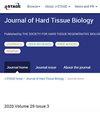Glucose Affects the Quality and Properties of Hard Tissue in Diabetes Mellitus Model
IF 0.4
4区 医学
Q4 ENGINEERING, BIOMEDICAL
引用次数: 0
Abstract
Patients with diabetes mellitus (DM) are at an increased risk of tooth loss compared to healthy individuals. Although studies human subjects suggest that diabetes control is affected by periodontitis, there is scarce mechanistic evidence supporting its biological plausibility. Therefore, using type 2 DM rat bone marrow mesenchymal stromal cells (BMMSCs) were incubated with four concentrations of glucose (5.5, 8.0, 12.0 or 24.0 mM), the effects of different glucose concentrations on BMMSCs stemness and osteogenesis were evaluated. High glucose concentrations decreased the fluorescence intensity of β-actin, STRO-1, CD73 and CD90. Moreover, cell proliferation decreased at high glucose concentrations. Alkaline phosphatase activity was decreased at 12.0 mM and 24.0 mM. In contrast, osteocalcin production and calcium deposition were considerably increased at 24.0 mM. Differences in the calcium/phosphate ratio associated with various glucose concentrations were similar to calcium deposition. The mRNA expression of Runx2 and inflammatory cytokines increased with increasing glucose concentration. The RANKL/OPG ratio decreased at high glucose concentrations. A high glucose concentration increased hard tissue formation, but the quality and stemness of the mineralized tissue decreased. Thus, hard tissue had a high risk of bone resorption in the case of uncontrolled diabetes even if periodontal treatment stabilized state of periodontitis for a moment.葡萄糖对糖尿病模型硬组织质量和性质的影响
与健康个体相比,糖尿病患者牙齿脱落的风险增加。虽然研究表明牙周炎影响糖尿病的控制,但缺乏支持其生物学合理性的机制证据。因此,以2型糖尿病大鼠骨髓间充质基质细胞(BMMSCs)与4种浓度的葡萄糖(5.5、8.0、12.0和24.0 mM)孵育,评估不同浓度葡萄糖对BMMSCs干细胞性和成骨的影响。高葡萄糖浓度降低了β-肌动蛋白、STRO-1、CD73和CD90的荧光强度。此外,在高葡萄糖浓度下,细胞增殖能力下降。碱性磷酸酶活性在12.0 mM和24.0 mM时降低。相反,骨钙素的产生和钙沉积在24.0 mM时显著增加。钙/磷酸盐比率与不同葡萄糖浓度相关的差异与钙沉积相似。随着葡萄糖浓度的升高,Runx2和炎症因子的mRNA表达增加。在高葡萄糖浓度下,RANKL/OPG比值降低。高葡萄糖浓度增加了硬组织的形成,但矿化组织的质量和干性下降。因此,在糖尿病不受控制的情况下,即使牙周治疗暂时稳定了牙周炎的状态,硬组织也有很高的骨吸收风险。
本文章由计算机程序翻译,如有差异,请以英文原文为准。
求助全文
约1分钟内获得全文
求助全文
来源期刊

Journal of Hard Tissue Biology
ENGINEERING, BIOMEDICAL-
CiteScore
0.90
自引率
0.00%
发文量
28
审稿时长
6-12 weeks
期刊介绍:
Information not localized
 求助内容:
求助内容: 应助结果提醒方式:
应助结果提醒方式:


